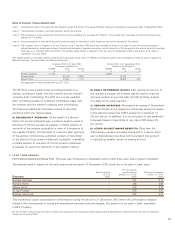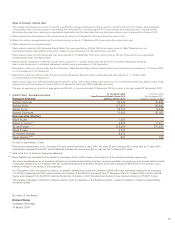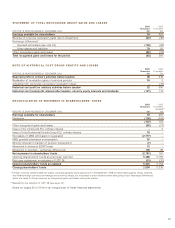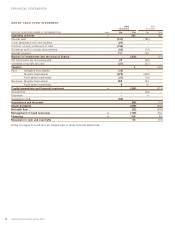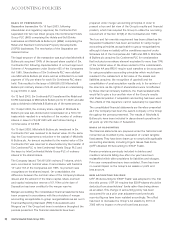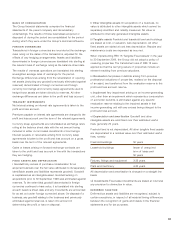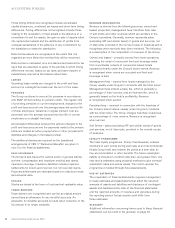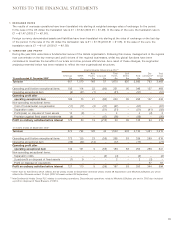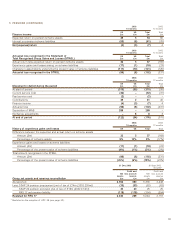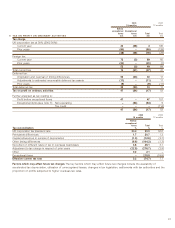Holiday Inn 2003 Annual Report Download - page 35
Download and view the complete annual report
Please find page 35 of the 2003 Holiday Inn annual report below. You can navigate through the pages in the report by either clicking on the pages listed below, or by using the keyword search tool below to find specific information within the annual report.
3333
BASIS OF CONSOLIDATION
The Group financial statements comprise the financial
statements of the parent company and its subsidiary
undertakings. The results of those businesses acquired or
disposed of during the period are consolidated for the period
during which they were under the Group’s dominant influence.
FOREIGN CURRENCIES
Transactions in foreign currencies are recorded at the exchange
rates ruling on the dates of the transactions, adjusted for the
effects of any hedging arrangements. Assets and liabilities
denominated in foreign currencies are translated into sterling at
the relevant rates of exchange ruling at the balance sheet date.
The results of overseas operations are translated into sterling
at weighted average rates of exchange for the period.
Exchange differences arising from the retranslation of opening
net assets (including any goodwill previously eliminated against
reserves) denominated in foreign currencies and foreign
currency borrowings and currency swap agreements used to
hedge those assets are taken directly to reserves. All other
exchange differences are taken to the profit and loss account.
TREASURY INSTRUMENTS
Net interest arising on interest rate agreements is taken to the
profit and loss account.
Premiums payable on interest rate agreements are charged to the
profit and loss account over the term of the relevant agreements.
Currency swap agreements are retranslated at exchange rates
ruling at the balance sheet date with the net amount being
included in either current asset investments or borrowings.
Interest payable or receivable arising from currency swap
agreements is taken to the profit and loss account on a gross
basis over the term of the relevant agreements.
Gains or losses arising on forward exchange contracts are
taken to the profit and loss account in line with the transactions
they are hedging.
FIXED ASSETS AND DEPRECIATION
i Goodwill Any excess of purchase consideration for an
acquired business over the fair value attributed to its separately
identifiable assets and liabilities represents goodwill. Goodwill
is capitalised as an intangible asset. Goodwill arising on
acquisitions prior to 30 September 1998 was eliminated against
reserves. To the extent that goodwill denominated in foreign
currencies continues to have value, it is translated into sterling
at each balance sheet date and any movements are accounted
for as set out under ‘foreign currencies’ above. On disposal of a
business, any goodwill relating to the business and previously
eliminated against reserves, is taken into account in
determining the profit or loss on disposal.
ii Other intangible assets On acquisition of a business, no
value is attributed to other intangible assets which cannot be
separately identified and reliably measured. No value is
attributed to internally generated intangible assets.
iii Tangible assets Freehold and leasehold land and buildings
are stated at cost, or valuation, less depreciation. All other
fixed assets are stated at cost less depreciation. Repairs and
maintenance costs are expensed as incurred.
When implementing FRS 15 ‘Tangible Fixed Assets’ in the year
to 30 September 2000, the Group did not adopt a policy of
revaluing properties. The transitional rules of FRS 15 were
applied so that the carrying values of properties include an
element resulting from previous valuations.
iv Revaluation Surpluses or deficits arising from previous
professional valuations of properties, realised on the disposal
of an asset, are transferred from the revaluation reserve to the
profit and loss account reserve.
v Impairment Any impairment arising on an income-generating
unit, other than an impairment which represents a consumption
of economic benefits, is eliminated against any specific
revaluation reserve relating to the impaired assets in that
income-generating unit with any excess being charged to the
profit and loss account.
vi Depreciation and amortisation Goodwill and other
intangible assets are amortised over their estimated useful
lives, generally 20 years.
Freehold land is not depreciated. All other tangible fixed assets
are depreciated to a residual value over their estimated useful
lives, namely:
Freehold buildings 50 years
Leasehold buildings lesser of unexpired
term of lease and
50 years
Fixtures, fittings and equipment 3-25 years
Plant and machinery 4-20 years
All depreciation and amortisation is charged on a straight line
basis.
vii Investments Fixed asset investments are stated at cost less
any provision for diminution in value.
DEFERRED TAXATION
Deferred tax assets and liabilities are recognised, subject to
certain exceptions, in respect of all material timing differences
between the recognition of gains and losses in the financial
statements and for tax purposes.




